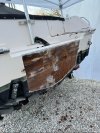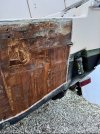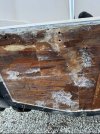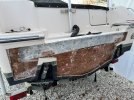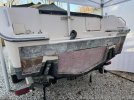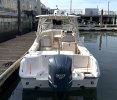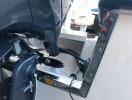I bought my boat, a 2011 275 Freedom, about four years ago. At the time the original “bang cap” for the transom, an aluminum piece at the time, was heavily corroded which created a route for some water to get into the transom, but the boat surveyed well. After buying the boat, I had the top of the transom permanently glassed over instead of replacing the cap/trim piece like for like because I wanted a permanent watertight seal on the transom.
Everything worked out fine until last year when I moved from California to Maryland and went through a true freezing winter. After that, a crack appeared along the top of my transom which multiple shops diagnosed as symptomatic of a wet transom that needed to be replaced.
I hired Annapolis Gelcoat in Annapolis to do the work. They are replacing the transom core with Coosa Bluewater 26. I figured you all might want to see the process play out.
The fiberglass pro has cut out the flat parts of the transom but appears to be leaving the complex areas, such as the recessed trim tabs and corners. Is this sufficient or does the entire back need to come off?
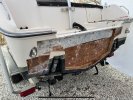
If anyone else has gone through a similar process with a SeeV2 hull with recessed tabs and has a photo of their job in progress, I’d welcome seeing it!
Everything worked out fine until last year when I moved from California to Maryland and went through a true freezing winter. After that, a crack appeared along the top of my transom which multiple shops diagnosed as symptomatic of a wet transom that needed to be replaced.
I hired Annapolis Gelcoat in Annapolis to do the work. They are replacing the transom core with Coosa Bluewater 26. I figured you all might want to see the process play out.
The fiberglass pro has cut out the flat parts of the transom but appears to be leaving the complex areas, such as the recessed trim tabs and corners. Is this sufficient or does the entire back need to come off?

If anyone else has gone through a similar process with a SeeV2 hull with recessed tabs and has a photo of their job in progress, I’d welcome seeing it!
Attachments
Last edited:


